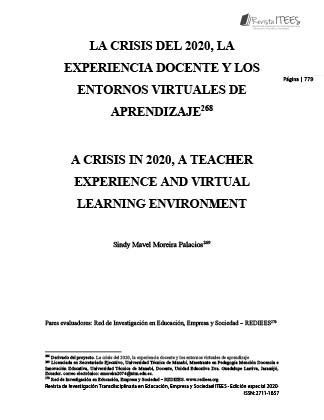XL. A CRISIS IN 2020, A TEACHER EXPERIENCE AND VIRTUAL LEARNING ENVIRONMENT
##plugins.themes.bootstrap3.article.main##
Abstract
Teaching praxis in virtual learning environments has been a topic of great interest for this
research work. In this sense, during the implementation with this alternative, the absence of this experience has been evidenced in the teachers of Zone 4 Santo Domingo de los TsáchilasManabí. The faculty of educators never imagined that a crisis like the one we are experiencing
(COVID-19) would force them to perform virtually through pedagogical accompaniment.
The objective of this study is to identify the factors that influence teaching practice and virtual
learning environments in the crisis of 2020, through bibliographic and field studies to
highlight the importance of preparing for the use of virtual tools and programs. The
methodology used corresponds to a qualitative approach that delves into teaching practice
and the new modality of telework, therefore, the data was collected through a survey and
virtual interviews, where the evidenced results show that it has been a challenge for teachers
adapt to current instructions as part of the teaching-learning process and educational
management. It is concluded that despite the different difficulties, the teachers have improved
in the use of virtual tools, however, the shortcomings can still be seen in relation to
communication, design, and execution of current educational programs.
Download Statistics
##plugins.themes.bootstrap3.article.details##
praxis, virtual environments, tools, teleworking, students
matemáticas en la educación basica - Universidad Autónoma Indígena de México. Ra
Ximhai, 11(4), 315 - 325. Doi:46142596023
Benavides, R. &. (2017). El Entorno Virtual de Aprendizaje (EVA) en la generación de
conocimiento de estudiantes universitarios. Cienciamérica, Escuela Superior
Politécnica de Chimborazo, Pontificia Universidad Católica del Ecuador, 1(6), 46-52.
Doi:6163727
Bernal, C. (2016). Metodologia de la Investigacion. Colombia: Pearson.
Caballero Lopez, J. E. (09 de 2009). Http://scielo.isciii.es. Obtenido de
http://scielo.isciii.es/pdf/mesetra/v55n216/revision.pdf
Cabrera, L. (2020). Efectos del coronavirus en el sistema de enseñanza: aumenta la
desigualdad de oportunidades educativas. Revista de Sociología de la Educación
(RASE), 13(2). Doi:10.7203/RASE.13.2.17125
Cedeño Romero, E. (2019). Entornos virtuales de aprendizaje y su rol innovador en el
proceso de enseñanza. Rehuso, Revista de Ciencias Humanísticas y Sociales, 4(1),
119-127. Doi: EIP.7047143
Contreras, G. &. (2019). Ambientes Virtuales de Aprendizaje: dificultades de uso en los
estudiantes de cuarto grado de primaria. Revista de Trabajo Social e intervención
social (27), 215-240. Doi:10.25100/prts. v0i27.7273
García, R. Y. (2017). Las Tic en la educación superior, innovaciones y retos. Revista
Iberoamericana de las Ciencias Sociales y Humanistas, 6(12). Doi:10.23913/ricsh.
v6i12.135
Gros Salvat, B. (2018). La evolución del e-learning: del aula virtual. RIED. Revista
Iberoamericana de Educación a Distancia, 21(2), 69-82. Doi:
http://dx.doi.org/10.5944/ried.21.2.20577
Guaña - Moya, e. A. (2015). Caracterización de entornos virtuales de enseñanza aprendizaje
(EVEA) en la educación virtual. Ciencias Holguín, Centro de Información y Gestión
Tecnológica de Santiago de Cuba, 21(4), 1-16. Doi:181542152006
Gutierrez Moreno, A. (2020). Educación en tiempos de crisis sanitaria: Pandemia y
educación. Praxis, 16(1). Doi:10.21676/23897856.3040
John, A. (2016). Normas Basicas de Higiene del Entorno en la atención sanitaria. India:
Organizacion Mundial de la Salud. Obtenido de
http://apps.who.int/iris/bitstream/handle/10665/246209/9789243547237-
spa.pdf;jsessionid=98A5D7C69806F077F4D7F5B862DCA0BB?Sequence=1
Morado, M. F. (2018). Entornos virtuales de aprendizaje complejos e innovadores: Una.
Revista Electrónica Educare, Universidad Nacional de Costa Rica, 22(1), 1 - 17.
Doi:10.15359/ree.22-1.18
Mora-Vicarioli, F. (2016). Trabajo colaborativo en ambientes virtuales de aprendizaje:
Revista Electrónica Educare, Universidad Estatal a Distancia, 20(2), 1-26. Doi:
http://dx.doi.org/10.15359/ree.20-2.19
Pitre et al. (2017). Acceso y uso de la web 2.0 en los ambientes educativos étnicos de
Riohacha-La Guajira. Revista Lasallista de Investigación, 14(1), 126-132.
Doi:69551301012
Saza-Garzón, I. (2016). ESTRATEGIAS DIDÁCTICAS EN TECNOLOGÍAS WEB PARA
PARA AMBIENTES VIRTUALES DE APRENDIZAJE. Revista Praxis, 12, 103-
110. Doi:10.21676/23897856.1851
Tarabini, A. (2020). ¿Para qué sirve la escuela? Reflexiones sociológicas. Revista de
Sociología de la Educación, 13(2), 145-155. Doi:10.7203/RASE.13.2.17135
Venegas&Beltran. (2020). Educar en época de confinamiento: La tarea de renovar un mundo
común. Revista de Sociología de la Educación (RASE), 13(2), 92-104.
Doi:10.7203/RASE.13.2.17187.





